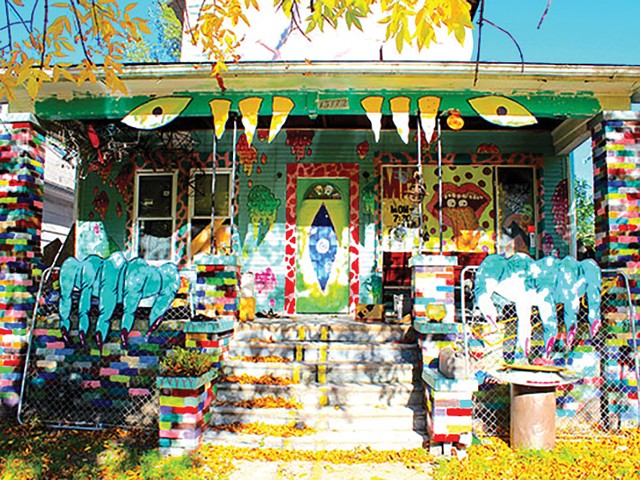What makes for a good bar story? Is it rollicking debauch? Triumph or tragedy? Hijinks or breakdown? The man to ask is, indisputably, writer Steve Hughes. He's been collecting and weaving tales from Detroit-area barstools since he moved to Hamtramck in 1995. These stories are encountered on the front lines of some of Hamtramck's finest dive bars — including Bumbos, New Dodge, Suzy's, Painted Lady, Kelly's, Lo and Behold, Seven Brother's, and Trixie's — sometimes transcribed almost directly, or else serving as jumping-off points for more fanciful narratives, eventually coming to be published in Stupor, Hughes' brainchild and "Detroit's longest-running zine."
Initially, Hughes created both the written content and designed collage-art style layouts, but soon converted to a system of collaboration on the illustration and graphic design with a rotation of area artists, including regular collaborators like Teresa Peterson and Tim Hailey, and names as big as Matthew Barney, Hygienic Dress League, and Scott Hocking. Hughes has been making Stupor ever since he settled in Hamtramck, and is now approaching publication of the 41st issue, working in collaboration with Hamtramck-based artist Alexander Buzzalini.
"This issue is a special one," Hughes says on a noisy night at Bumbos. "It's been a long time since I made one, and me and Alex decided we were going to go to the bar. We recorded all the stories with my video camera. Usually I just go out and putz around and listen to people talk and I build the issue over a long period of time, but this one we gathered pretty much all the stories in one night."
The theme of the upcoming issue, which will drop on Oct. 8 as part of activities during the Hamtramck Neighborhood Arts Festival, is Soft Gun/Failure, which refers to a soft sculpture piece by Buzzalini that particularly caught Hughes' attention.
"It was such a great example of failure," he says. "In terms of the gun, which can't work, but also because it's such a masculine item and it's drooping, and it can never come back up and do its job."
Buzzalini laughs at this comment. Buzzalini, who's been living in Hamtramck for the last five years, has an easygoing nature that belies an association with failure. In speaking about the soft sculpture piece that inspired the issue, Buzzalini refers to sculptor Claes Oldenburg, whose oversized and soft fabric renditions of everyday objects are his claim to fame.
"It's a sculpture in a frame with a red velvet background to mimic dueling pistols," says Buzzalini, whose work largely deals with conventional archetypes of masculinity, particularly cowboys.
"I always liked Alex's cowboys because of the sort of failure that they exhibit," Hughes says.
Buzzalini agrees.
"I think that's where Steve and I connected on the collaboration," he says. "My painting is all about exposing the reality in these false landscapes of cowboys and Westerns — the idealized cowboy is not really superhuman. He could be a loser or just a normal guy, and sometimes bad things happens to him."
When it comes to Hughes and his roving crew of bar-going buddies, there is always a sense of humor and off-the-cuff good times, but his stories are more haunting, often tinged with darker aspects of the human condition, as is perhaps to be expected of people who treat their local bar as the equivalent of a therapist's office.
"There's a real human quality to not being perfect," Hughes says. "That's a pretty important thing, you know? I like the bar, it's this place where people go and they drink, and they maybe become more themselves, because they can't really be themselves without having a couple drinks. And then once they are themselves, they end up being lunatics, in a way — and they have pretty good stories."
Hughes' writing is extremely sympathetic to these characters, many of whom seem to lack self-awareness to a destructive degree. Whether they are blowing up their relationships, causing property damage, or puzzling over losing jobs, Stupor rarely captures humanity at its most triumphant. And yet, Hughes, who received his MFA in creative writing from University of New Orleans, achieves moments of transcendence and linguistic beauty, even in the mire of inebriation and failure. A man forcing his unwanted attentions on a lady at the bar pauses to reflect that her loose bun looks like "a little nest for dust." Hughes manages to draw poignancy and humanity out of unambiguously vile moments.
While each issue has an organizing theme, there are some oft-recurring motifs: drinking, and drinking problems, loneliness, sex and infidelity, anger and self-loathing. Hughes touted these as universal concerns, asserting that Stupor's audience is "everyone."
He paused to think about that. "Not kids," he amends. The zine itself has a tall, narrow format, fitting stories and imagery together in a chimneystack layout that makes Stupor, with its signature self-deprecating humor, a great self-stated choice of bathroom reading. This issue will be printed by Cache Printing Services' Jeff Evergreen, who uses a boutique form of risograph printing technology to create the four-color final product on a kind of copy machine that rolls out each color with a different drum. The result creates appealing, but none-too-high-tech aesthetics, which matches Stupor's overall image as the everyman publication.
As we reached the end of the round, I asked again, what makes a good bar story?
"Love and loss," Buzzalini says, eyes twinkling.
"I really like a good screwed-up story," says Hughes. "Where there's something wrong with the telling, there's a kind of disconnect to it."
"They are missing something," he says with a grin. "I really like that."
You can catch Stupor: Soft Gun/Failure at the official launch party at 8 p.m. on Saturday, Oct. 8 at 12123 St. Aubin St. during the 2016 Hamtramck Neighborhood Arts Festival. The event will feature a musical performance by Augusta Morrison and live readings of Stupor stories by Hughes, Buzzalini, Ryan Standfest of Rotland Press, and artist Jessica Frelinghuysen, among others. Issues also available at Public Pool art gallery, or stuporzine.com.




